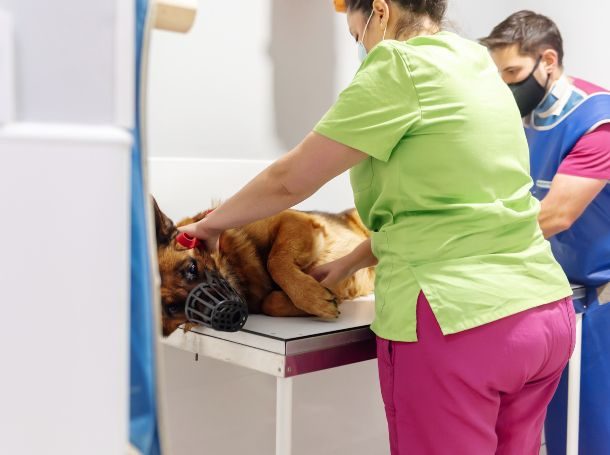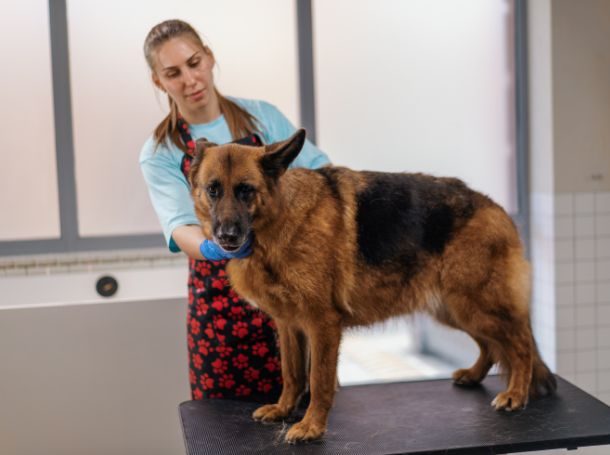
How to Identify Dog Food Allergies: Symptoms, Causes, and Solutions
- March 7, 2025
Table of Contents
Food allergies in dogs can be challenging for pet owners to detect. It’s important to recognize the signs early on to ensure your furry friend gets the proper treatment. This guide will walk you through the key symptoms, causes, and solutions for identifying and managing dog food allergies. Let’s dive in!
What Are Dog Food Allergies?
Food allergies occur when a dog’s immune system mistakenly identifies a harmless ingredient in food as a threat. This triggers an immune response that can cause a variety of symptoms. It’s important to differentiate food allergies from food sensitivities.
Food allergies involve an immune response that leads to an inflammatory reaction, whereas food sensitivities are typically less severe and do not involve the immune system.
Common Allergens for Dogs
Some ingredients are more likely to cause food allergies in dogs. These include:
- Proteins: Beef, chicken, lamb, dairy, and fish are the most common allergens.
- Grains: Wheat, soy, and corn are frequently reported to cause allergic reactions.
- Other Ingredients: Artificial additives, preservatives, and food coloring can also trigger allergic reactions.
If you suspect your dog has food allergies, it’s essential to identify which ingredient is the culprit.
How to Recognize Dog Food Allergy Symptoms

Identifying food allergies in dogs is often tricky because the symptoms can vary widely. Below are the most common signs that your dog might be allergic to something in their food.
1. Skin Issues
One of the most common signs of a food allergy is itching or inflammation. Dogs with food allergies often develop:
- Itchy skin: Dogs may scratch excessively, lick their paws, or rub their face.
- Hot spots: These are painful, red, moist areas of the skin that can become infected.
- Rashes or hives: Raised, red bumps may appear on your dog’s skin.
- Ear infections: Frequent, recurrent ear infections, often accompanied by a foul smell and discharge, can be a sign of food allergies.
If you notice your dog constantly itching or developing sores on their skin, food allergies might be the cause.
2. Digestive Issues
Food allergies often affect the digestive system. Symptoms to watch out for include:
- Vomiting: Dogs may vomit shortly after eating.
- Diarrhea: Chronic diarrhea or soft stools are common signs of food allergies.
- Flatulence: Excessive gas or bloating can indicate that your dog’s digestive system is reacting poorly to something in their food.
If your dog experiences consistent digestive upset, it’s a good idea to consider whether food allergies might be at play.
3. Respiratory Problems
Though less common, some dogs may exhibit respiratory signs when allergic to food:
- Coughing: Persistent coughing that doesn’t seem to be caused by a cold or infection.
- Sneezing: Frequent sneezing or nasal congestion.
- Wheezing or labored breathing: This is a more serious symptom and should be addressed by a vet immediately.
4. Behavioral Changes
Dogs that suffer from food allergies may also experience changes in behavior due to discomfort. Look out for signs like:
- Restlessness: Your dog may seem agitated or uncomfortable.
- Excessive licking or chewing: Some dogs will lick their paws or chew at their bodies to soothe their itchy skin.
What Causes Dog Food Allergies?
The exact cause of food allergies in dogs is not entirely understood, but several factors can contribute to their development:
Genetics
Certain dog breeds are more predisposed to food allergies. Breeds like Golden Retrievers, Boxers, West Highland Terriers, and Bulldogs are more likely to develop food allergies.
Immune System Sensitivity
Dogs with overly sensitive immune systems are more prone to developing food allergies. Over time, the immune system learns to mistake certain proteins in food as harmful invaders, triggering allergic reactions.
Early Diet and Exposure
Puppies who are exposed to only one type of protein early on may be more likely to develop allergies to that protein later in life. A lack of variety in a dog’s diet, particularly during the early stages of life, may increase the risk of developing food allergies as they mature.
Overexposure to Certain Ingredients
If a dog is repeatedly exposed to a particular protein or carbohydrate (such as chicken or wheat), their immune system may become sensitized to it, leading to an allergic reaction.
How to Diagnose Dog Food Allergies
Accurately diagnosing food allergies in dogs can be difficult because the symptoms overlap with other health issues. Here are the most common methods used to diagnose food allergies:
1. Elimination Diet
The elimination diet is the gold standard for diagnosing food allergies. It involves removing all common allergens from your dog’s diet and feeding them a novel protein (like duck or venison) and a simple carbohydrate (like sweet potato) that they’ve never eaten before. This is done for 8-12 weeks.
If your dog’s symptoms improve during this time, it’s likely that they have a food allergy. Afterward, you slowly reintroduce the suspected allergens one at a time to pinpoint the exact cause of the allergy.
2. Blood Tests
Some veterinarians use blood tests to identify food allergies. These tests measure the immune system’s response to various food proteins. However, blood tests for food allergies are often less reliable than the elimination diet, and they should be used in conjunction with other diagnostic methods.
3. Skin Tests
Skin tests, similar to the ones used for humans, can sometimes be used to detect food allergies. However, they are more commonly used for environmental allergies and may not be as effective for diagnosing food-related issues.
Treatment and Management of Dog Food Allergies

Once a food allergy is identified, the next step is treatment. There are several ways to manage your dog’s food allergies, and your vet will likely recommend a combination of the following approaches:
1. Switching to a Hypoallergenic Diet
The most effective way to manage food allergies is to switch to a hypoallergenic diet. These diets contain novel proteins (like duck, venison, or fish) and carbohydrates (such as sweet potatoes or peas) that your dog has not been exposed to previously. Some popular hypoallergenic dog foods are specifically designed to minimize allergic reactions by using limited ingredients.
2. Avoiding the Allergen
Once you know which ingredient is causing your dog’s allergies, it’s important to avoid that ingredient in all future meals. For example, if your dog is allergic to chicken, you’ll need to choose foods that are chicken-free.
3. Using Supplements and Medications
In some cases, your vet may recommend supplements to help with your dog’s symptoms. These could include omega-3 fatty acids to reduce inflammation or antihistamines to alleviate itching. For severe allergic reactions, corticosteroids may be prescribed for short-term relief.
4. Regular Vet Check-Ups
Your dog’s dietary needs may change over time. Regular check-ups with your vet are important to monitor your dog’s health and adjust their diet or treatment plan as necessary.
Preventing Dog Food Allergies
While food allergies can’t always be prevented, there are steps you can take to reduce the likelihood of your dog developing one:
1. Introduce a Variety of Foods Early
Introducing a variety of protein sources and carbohydrates to your dog early on may help prevent allergies from developing. This variety allows their immune system to build tolerance to different food ingredients.
2. Rotate Protein Sources
If your dog is prone to allergies, rotating between different protein sources (like beef, chicken, and fish) can help prevent sensitivity to any one protein.
3. Consult Your Veterinarian
Regular visits to the vet for health checks and nutrition advice can help ensure your dog stays healthy and receives the right diet from the start.
What to Do If You Suspect Your Dog Has a Food Allergy

If you suspect your dog is suffering from a food allergy, here’s what you should do:
- Consult Your Veterinarian: Always start with a vet visit to rule out other potential health issues.
- Start an Elimination Diet: If your vet agrees, begin the elimination diet to identify the allergen.
- Monitor Your Dog’s Symptoms: Keep a detailed log of symptoms and improvements.
- Make Dietary Changes: Once the allergen is identified, choose a suitable hypoallergenic food.
Conclusion
Food allergies in dogs can be a frustrating and confusing issue to deal with. Recognizing the symptoms early, diagnosing the problem, and working with your vet to find the right treatment plan can make a world of difference for your dog’s health and quality of life.
If you think your dog may have a food allergy, don’t hesitate to reach out to your veterinarian to get started on the path to a healthier, happier pet.
FAQ
Common allergens include proteins like beef, chicken, and fish, as well as grains like wheat and soy.
Signs include itchy skin, vomiting, diarrhea, ear infections, and behavior changes like excessive licking.
The best way is an elimination diet, where you remove potential allergens and gradually reintroduce them to identify the trigger.
Yes, food allergies can develop at any age, even in dogs who have been eating the same food for years.
Switch to a hypoallergenic diet, avoid allergens, and consult your vet for supplements or medications to manage symptoms.




Leave a comment